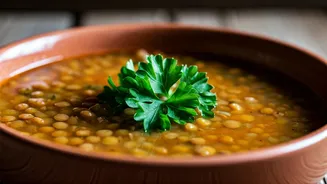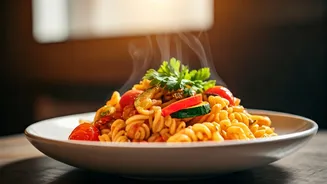A Culinary Legacy
This Lebanese lentil soup embodies more than just a recipe; it's a culinary heritage passed down through years. This soup is not only a food item but also
a symbol of family, history, and the comforting embrace of a warm meal. Over the years, this soup has been part of celebrations, shared amongst loved ones. It tells a story of tradition, of the meticulous selection of ingredients and the patient preparation that builds up each layer of flavor. It also represents the resilience of cultural traditions in the face of time, remaining steadfast in its place within the heart of the Lebanese home. The appeal lies in its simplicity, making it a favorite for both everyday meals and special occasions.
Essential Ingredients Unveiled
To begin, gather the essential ingredients that bring this Lebanese lentil soup to life. The star is undoubtedly the humble lentil, providing a hearty base. Red lentils are the top choice for this soup due to their quick cooking time and creamy texture. Alongside the lentils, you'll need aromatics: onions, garlic, and often a touch of cumin. These components form the aromatic base, building layers of savory depth. A blend of spices, including coriander, and turmeric, provides warmth and earthy undertones. Olive oil is key for sautéing the vegetables and creating a rich base. The soup also frequently includes a garnish of fresh lemon juice, which offers a zesty contrast to the soup's richness. These ingredients, when combined harmoniously, create the unforgettable flavor profile of this traditional dish.
Preparing The Soup
The journey of making this Lebanese lentil soup starts with the preparation of the aromatics. The onions, garlic, and any other vegetables are delicately sautéed in olive oil until they become softened and fragrant. Next, the lentils are added and briefly toasted, which enhances their flavor. Water or broth is then poured into the pot, bringing the soup to a simmer. Spices are added at this stage, infusing the liquid with their distinct aromas. Once the lentils are tender, the soup is then ready to be blended. Some prefer a smooth consistency, achieved with an immersion blender or a traditional blender. After blending, the soup is often simmered for a while, allowing the flavors to marry together. Finally, a squeeze of fresh lemon juice is added, to provide a bright, balancing finish.
Variations and Twists
This Lebanese lentil soup welcomes personalization, allowing cooks to customize it to their preferences. A common variation includes the addition of vegetables like carrots or potatoes, lending the soup a heartier texture. Some cooks introduce a smoky depth by including smoked paprika. A swirl of yogurt or a drizzle of tahini add creamy notes. For a spicier edge, a pinch of cayenne pepper or a dash of harissa paste can be included. This dish is known to be flexible, easily transformed to meet different tastes and dietary needs. Whether you prefer it smooth or chunky, with added vegetables or a touch of heat, the essence of the soup remains: a flavorful, comforting experience.
Serving and Enjoying
This Lebanese lentil soup is most often served warm, the ultimate comfort food for any occasion. Often, the soup is accompanied by crusty bread, perfect for soaking up the delicious broth. Fresh lemon wedges are available, allowing guests to add brightness and acidity. Fresh herbs such as parsley or cilantro are usually added as a garnish. In Lebanon, this soup frequently takes its place on the table during family gatherings, where sharing a meal creates lasting bonds. The soup can also be adapted, as some may choose to add a dollop of yogurt, which adds a creamy texture. It can be paired with a simple salad to round out the meal. No matter how it is presented, the joy of this soup is in its communal nature, bringing people together around a simple but special dish.









